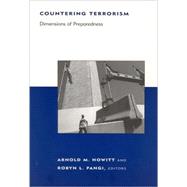
Note: Supplemental materials are not guaranteed with Rental or Used book purchases.
Purchase Benefits
| Acknowledgments | p. xi |
| Introduction | p. 1 |
| Strategies and Institutions | |
| The Architecture of Government in the Face of Terrorism | p. 17 |
| Intergovernmental Challenges of Combatting Terrorism | p. 37 |
| Dealing with Terrorism after September 11, 2001: An Overview | p. 57 |
| Lessons of the "War" on Drugs for the "War" on Terrorism | p. 73 |
| Emerging Threats | |
| Biological Terrorism: Understanding the Threat and America's Response | p. 97 |
| Nuclear Terrorism: Risks, Consequences, and Response | p. 175 |
| Covert Biological Weapons Attacks against Agricultural Targets: Assessing the Impact against U.S. Agriculture | p. 195 |
| Cyber Attacks: Protecting America's Security against Digital Threats | p. 219 |
| Capacity Building | |
| U.S. Preparations for Biological Terrorism: Legal Limitations and the Need for Planning | p. 253 |
| Ambulances to Nowhere: America's Critical Shortfall in Medical Preparedness for Catastrophic Terrorism | p. 283 |
| Emergency Communications: The Quest for Interoperability in the United States and Europe | p. 299 |
| Lessons Learned from International Cases | |
| Israel's Preparedness for High Consequence Terrorism | p. 345 |
| Consequence Management in the 1995 Sarin Attacks on the Japanese Subway System | p. 371 |
| Civil Liberties, Terrorism, and Liberal Democracy: Lessons from the United Kingdom | p. 411 |
| About the Authors | p. 447 |
| Index | p. 459 |
| About the Belfer Center for Science and International Affairs | p. 480 |
| Table of Contents provided by Publisher. All Rights Reserved. |
The New copy of this book will include any supplemental materials advertised. Please check the title of the book to determine if it should include any access cards, study guides, lab manuals, CDs, etc.
The Used, Rental and eBook copies of this book are not guaranteed to include any supplemental materials. Typically, only the book itself is included. This is true even if the title states it includes any access cards, study guides, lab manuals, CDs, etc.